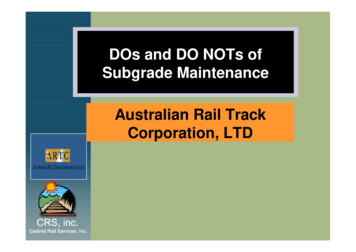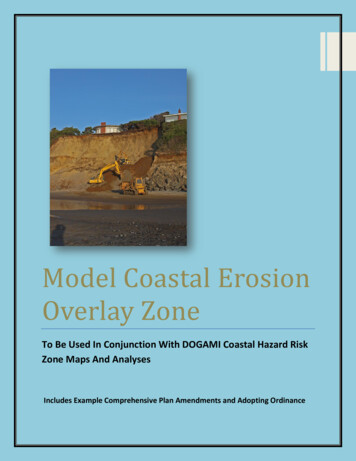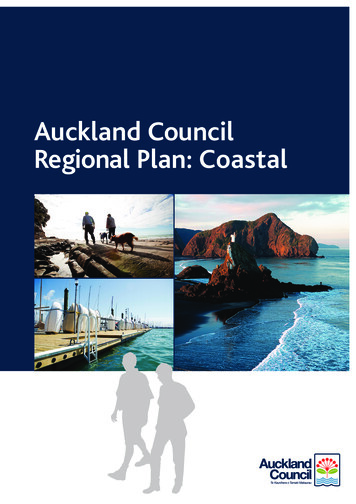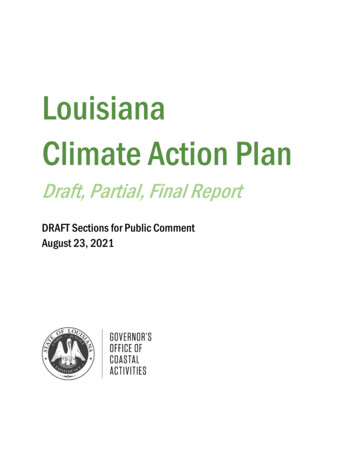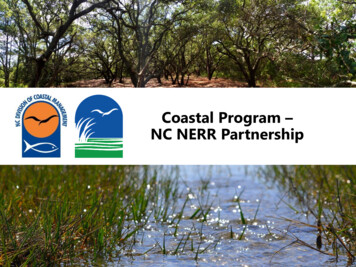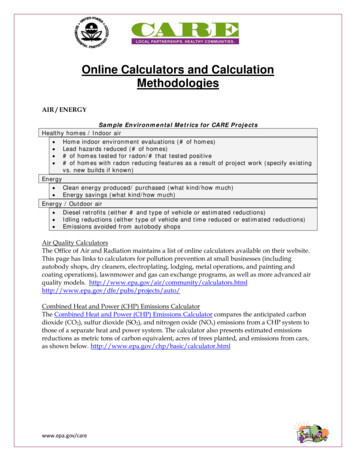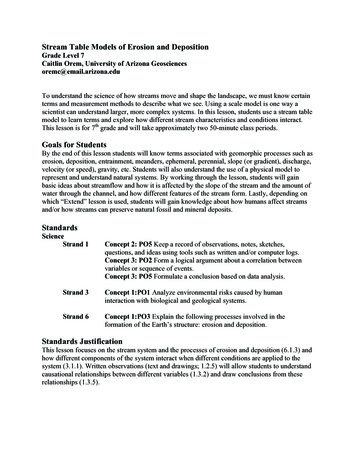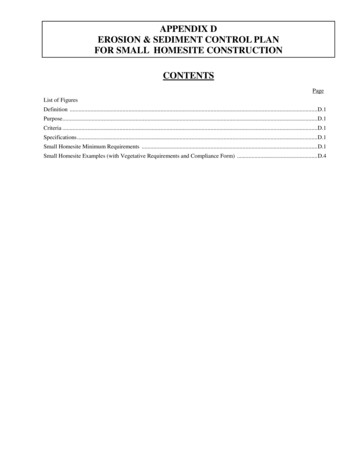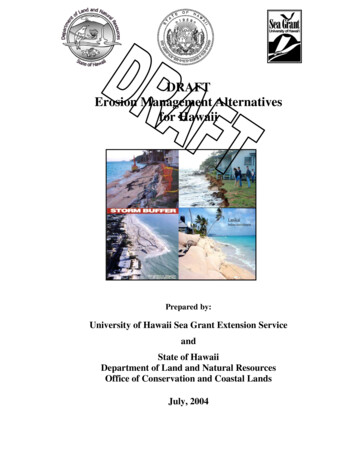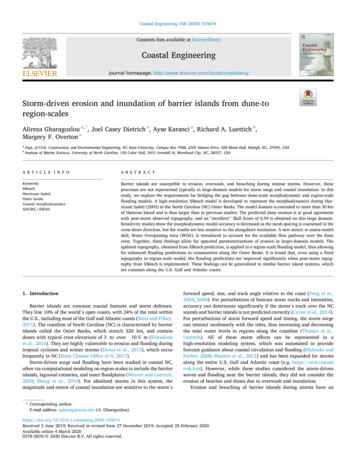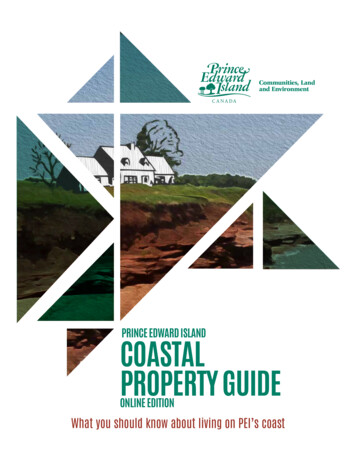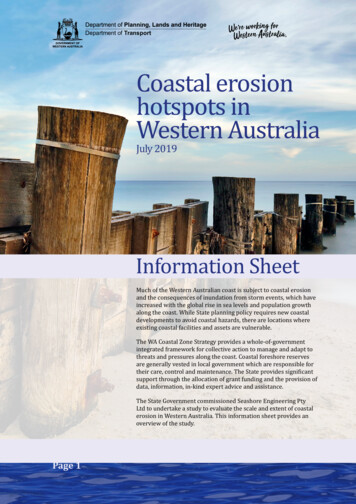
Transcription
Department of TransportCoastal erosionhotspots inWestern AustraliaJuly 2019Information SheetMuch of the Western Australian coast is subject to coastal erosionand the consequences of inundation from storm events, which haveincreased with the global rise in sea levels and population growthalong the coast. While State planning policy requires new coastaldevelopments to avoid coastal hazards, there are locations whereexisting coastal facilities and assets are vulnerable.The WA Coastal Zone Strategy provides a whole-of-governmentintegrated framework for collective action to manage and adapt tothreats and pressures along the coast. Coastal foreshore reservesare generally vested in local government which are responsible fortheir care, control and maintenance. The State provides significantsupport through the allocation of grant funding and the provision ofdata, information, in-kind expert advice and assistance.The State Government commissioned Seashore Engineering PtyLtd to undertake a study to evaluate the scale and extent of coastalerosion in Western Australia. This information sheet provides anoverview of the study.Page 1
Study scope and overviewA total of 55 locations (15 Perth metropolitan and 40 regional) were identified as ‘hotspots’,where coastal erosion is expected to impact on public and private physical assets and requiremanagement and adaptation action within 25 years (see Figure 1). A hotspot typically has thefollowing characteristics:1. Proximity: infrastructure close to the existing shore, or landward of progressively andrapidly eroding coast2. Instability: typically, subject to progressive or episodic erosion3. Mitigation cost: costs of likely forms of erosion mitigation are high4. Transfer: limited capacity to manage future erosion using existing coastal protectionmeasures or extension of existing coastal protection is likely to exacerbate erosiontransfer5. Community: highly valued by the community.A detailed profile has been prepared for each of these locations, which span 29 localgovernment areas, and include three under State management responsibility (the Departmentof Biodiversity, Conservation and Attractions (DBCA), Fremantle Ports and the Southern PortAuthority). An additional 31 locations (8 Perth metropolitan and 23 regional) were placed ona watch-list for possible future consideration. Hence, a total of 86 locations, within 34 localgovernment areas, identified as potentially vulnerable to coastal erosion in the longer term.The study confirms the need to plan for coastal erosion hazard risk management andadaptation. It is a high-level assessment that allows for comparison between hotspots. Theoptions presented for each hotspot are only a guide and do not replace the need for moredetailed investigations with implementation plans at local scale as part of comprehensivecoastal hazard risk management and adaptation planning.The nature of erosionErosion is a natural coastal process that creates hazards and may threaten coastal assets and/or values. The cause of erosion and its impacts varies between locations, influencing possiblemanagement solutions.The dominant causes of erosion hazard risk along Western Australia’s identified coastalhotspots are: man-made coastal structures changing natural patterns of sand movement along thecoast landforms which become unstable under naturally-changing sand supply, extreme orlong-term changes in weather and wave conditions coastal response to rising sea level. inherently unstable landforms due to underlying geology or geographic locationfacilities and assets built close to the coast that cannot withstand erosionCoastal erosion hotspots in Western AustraliaInformation SheetPage 2
0N100200300400kilometresProduced by Data Analytics,Department of Planning, Lands and Heritage,on behalf of the Western Australian Planning Commission.Copyright November 20181. China Town, \CoastalHotspots\CoastalErosionHotSpotsSites ranking.mxdBase information supplied byWestern Australian Land Information AuthoritySLIP 1096-2018-12. BroomeTown Beach4. Laurentius Point,Port Hedland3. Goode St,Port HedlandEnlargement AEnlargement BA9. Horrocks Foreshore10. Drummond Cove,Geraldton11. Sunset Beach, Geraldton12. Beresford, GeraldtonB13. Point Moore,Geraldton5. Warne St & Yacht Club, Exmouth14. Grannies Beach,IrwinEnlargement C6. Pelican Point, Carnarvon15. Cervantes16. Grey7. Monkey Mia8. Denham Townsite17. Wedge18. Grace Darling Park,Lancelin19. Ledge Point20. Seabird Foreshore,Gingin21. Two Rocksnorthern coastC22. QuinnsBeachEnlargement D23. MAAC Seawall,Joondalup24. Watermans Bay25. Mettams Pool28. Rottnest South Thomson BayDF26. Floreat BeachHG27. Port Beach29. C.Y. O'ConnorBeachE49. Windy Harbour55. Esperance Town Beach53. Bremer Bay Fishery Beach52. Emu Point, Albany51. Ocean Beach, Denmark50. Peaceful Bay, DenmarkEnlargement E30. Kwinana waterfrontindustrial leases31. Kwinana Beach32. Rockingham townsite34. Point Peronto Causeway(N Shoalwater Bay) 35. Waikiki Beach,Rockingham54. Hopetoun Foreshore48. Gnarabup S33. N Point Peron(W of Causeway)37. Doddies Beach,Roberts Point36. Mandurah northern beaches42. Wonnerup Beach (E)43. Wonnerup Beaches46. Abbey,Busselton44. King St47. Locke Estate45. Craig St, Busselton39. BinningupSeawall40. The Cut, Bunbury41. Koombana Beach38. Falcon Bay to Rakoa StEnlargement FEnlargement GEnlargement HFigureerosionhotpotsand managementimportanceimportanceFigure1 1- Coastal- Coastalerosionhotspotsand managementCoastal erosion hotspots in Western AustraliaInformation SheetPage 3
Assets at riskThree timeframes were used to assess potential erosion hazards and to allow for progressivedecision-making, from present-day risk management to longer-term adaptation: Imminent (0 to five years) Projected ( 25 years) Expected (five to 25 years)Assets and recreational activities threatened by erosion for each of the three timeframes wereidentified at each hotspot.Table 1 shows the asset classes susceptible to erosion. Key findings include: 80 per cent of hotspots have recreational assets susceptible to erosion in the nextfive years. 49 per cent of hotspots have road and/or rail infrastructure at risk in the five-to-25year timeframe, increasing to 76 per cent projected beyond 25 years. Five hotspots have private property at risk in the next five years, increasing to 10hotspots within five to 25 years, and 26 hotspots projected beyond 25 years.36 per cent of hotspots have leasehold property susceptible to erosion in the five-to25-year timeframe.Table 1: Summary of hotspots with asset classes susceptible to erosionAsset atingSLSC/rescueSand beachaccessSand boatlaunchingNumber (per cent) of hotspots0-5 years5-25 18(36%)(49%)(84%)(31%)(11%)(71%)(33%)Coastal erosion hotspots in Western AustraliaInformation SheetPage 425 3%)
Management importanceTo facilitate a strategic approach to coastal erosion management efforts, a framework forcomparing the relative importance of managing erosion for each hotspot was developedby considering the number and monetary value of public assets subject to erosion, coupledwith potential loss of recreational uses and private or leasehold property. Figure 1 shows thelocation of the 55 hotspots and their relative management importance.A total of 21 of the 55 hotspots have high management importance within the next 25 years(Table 2). Of these, in the next five years: two hotspots have high and pressing management importance: Port Beach and SouthThomson’s Bay in Rottnest Island Seven hotspots have low management importance: Denham townsite, Sunset BeachGeraldton, Grannies Beach, Cervantes, MAAC Seawall Joondalup, C.Y. O’Connor Beachand Emu Point Albany. 12 hotspots have moderate management importance: Broome Town Beach, MonkeyMia, Drummond Cove, Grace Darling Park (Lancelin), Ledge Point, Seabird, MettamsPool, Floreat Beach, Kwinana waterfront industrial leases, Rockingham Town Beachto Causeway, Mandurah northern beaches and Koombana Bay (Bunbury)While there is a focus on hotspots with high management importance within the next 25years, appropriate management of coastal assets is required at all hotspots.Table 2: Summary of hotspot management importanceGroup Number of hotspotsrank TotalMetropolitan12345678Total212761951355 212422 8(38%)401015 (27%)Management importanceRegional0854 13(62%)1550340 (73%)Coastal erosion hotspots in Western AustraliaInformation SheetPage 50-5 years5-25 years25 yearsHHHMMHLLMLLLLHHMMLHHHMHL
Management and adaptation pathwaysA high-level assessment of erosion management options and adaptation pathways wasundertaken for each location.State Coastal Planning Policy (SPP2.6) requires that adequate coastal hazard risk managementand adaptation planning is undertaken where existing or proposed development is at risk ofbeing affected by coastal hazards. SPP2.6 outlines a hierarchy of adaptation measures in thefollowing order: avoid, planned or managed retreat, accommodate and protect.Protection is currently the main strategy used by coastal managers to manage coastalerosion. While this is expected to continue over the next five years, it is not always a completesolution due to erosion transfer and the potential loss of socio-economic values of the beach.Over the next five to 25 years, planned or managed retreat – which includes relocation ofassets, removal of assets and landward movement of a reserve boundary – becomes a moreimportant adaptation measure.Recommended actionsThe study recommends the following actions to address issues associated with governanceand management of hotspots:1. State Government to provide integrated coastal planning and engineering support tolocal coastal managers.2. Local coastal managers to prepare detailed hotspot-specific Coastal Hazard RiskManagement and Adaptation Plans (CHRMAP) to address the risk to public andprivate assets from coastal hazards.13. Prepare a community education strategy to raise awareness about coastal processesand coastal hazard risk management and adaptation planning.*4. Undertake a State-wide comprehensive review of lease agreements to support coastalmanagement and adaptation pathways.5. Review and clarify management arrangements and responsibilities for all hotspotscontaining unallocated Crown land.6. Determine the socio-economic value of coastal foreshores to assist in assessingadaptation options.7. Develop a more accurate methodology of predicting coastal change for developedcoasts to better inform short to medium-term adaptive management.*1. This recommendation has been shortened from the original which has 7 specific matters to be addressed– see the study for detail.* These recommendations have been shortened – see the study for detail.Coastal erosion hotspots in Western AustraliaInformation SheetPage 6
The study also recommends the following additional actions to address information gaps forcoastal erosion assessment and management:i.Acquire coastline movement data for all hotspots and watch-list locations (ormaintain acquisition where data is currently collected).ii. Collect information on local coastal dynamics to better understand sand movement,landform stability and shoreline response at hotspot specific scale.iii. Commission geotechnical investigations for specific hotspots, starting with thosewhere private, leasehold, road/rail and services are susceptible to erosion hazardwithin 25 years.iv. Review the demand for, cost and availability of, basic raw materials for coastalprotection, including coarse sand for renourishment and rock for construction oferosion mitigation structures.v. Develop improved hotspot management histories to refine projected coastal trendsand use as a basis for recording ongoing maintenance.*vi. Prepare low-cost monitoring programs for each region to assist local coastalmanagers in understanding their foreshore and determine when a change inmanagement is triggered.vii. Identify long-term and regional variations of meteorological and oceanographic data(mainly collected by Department of Transport and the Bureau of Meteorology) tosupport better interpretation of coastal trends.viii. Review the hotspot and watch-list locations on a five-yearly basis, to determine if anywatch-list locations should be considered as hotspots or if any additional locationsshould be added to the watch-list. For any new hotspot locations, management andadaptation plans should be developed following identification.ix. Prepare material illustrating retreat case studies previously undertaken by localcoastal managers in Western Australia to be considered when assessing retreat as anoption for private property and leaseholds.* These recommendations have been shortened – see the study for detail.Coastal erosion hotspots in Western AustraliaInformation SheetPage 7
Coastal erosion hotspots in Western Australia Much of the Western Australian coast is subject to coastal erosion . (DBCA), Fremantle Ports and the Southern Port Authority). An additional 31 locations (8 Perth metropolitan and 23 regional) were placed on a watch-list for possible future consideration. Hence, a total of 86 locations, within 34 .
